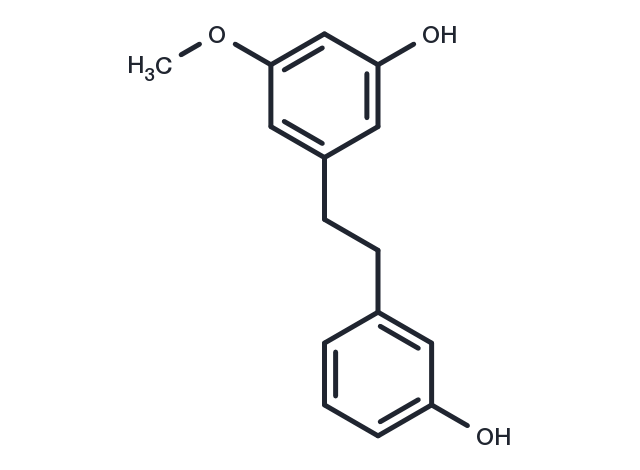Powder: -20°C for 3 years | In solvent: -80°C for 1 year


Batatasin III inhibits cancer migration and invasion by suppressing epithelial to mesenchymal transition and FAK-AKT signals and possesses anti-cancer activities. Batatasin III has a long-term inhibitory effect on whole-plant growth and shows germination

| Pack Size | Availability | Price/USD | Quantity |
|---|---|---|---|
| 1 mg | In stock | $ 179.00 | |
| 2 mg | In stock | $ 269.00 | |
| 5 mg | In stock | $ 455.00 | |
| 10 mg | In stock | $ 672.00 | |
| 25 mg | In stock | $ 1,060.00 | |
| 50 mg | In stock | Inquiry |

| Description | Batatasin III inhibits cancer migration and invasion by suppressing epithelial to mesenchymal transition and FAK-AKT signals and possesses anti-cancer activities. Batatasin III has a long-term inhibitory effect on whole-plant growth and shows germination |
| In vivo | Batatasin III may impose a lethal effect on the aquatic fauna in small streams. The maximum concentration of Batatasin III found was 1.06 mg l(-1). The proportion of dead yolk sac alevins increased significantly (P < 0.001) with increasing concentrations of Batatasin III and time of exposure. After 24 hr, EC50 was 10 mg l(-1). It was 2 mg l(-1) after 48 hr. The effect of phenol was negligible, indicating a specific phytotoxic effect of the bibenzyl structure of Batatasin III. The proportion of mobile D. magna became significantly smaller (P < 0.001) with increasing concentrations of Batatasin III, with decreasing pH, and with increasing exposure time. EC50 varied between 7 and 17 mg l(-1) at pH 5.5 and 7.0, respectively. After 24 hr EC50 decreased and was 2.5 at pH 5.5 and 12 mg l(-1) at pH 7.0. The levels of Batatasin III found in the field samples were below the lowest EC50 in acute toxicity tests[1]. Batatasin III significantly suppresses mesenchymal transition indicated by the decrease of N-cadherin and Vimentin and up-regulation of E-cadherin[1]. Batatasin III (25-100 μM; 48 h) exhibits anti-proliferative activity in H460 cells. Batatasin III at concentrations lower than 100 μM has no cytotoxic effects[2]. |
| Source |
| Molecular Weight | 244.29 |
| Formula | C15H16O3 |
| CAS No. | 56684-87-8 |
Powder: -20°C for 3 years | In solvent: -80°C for 1 year
You can also refer to dose conversion for different animals. More
bottom
Please see Inhibitor Handling Instructions for more frequently ask questions. Topics include: how to prepare stock solutions, how to store products, and cautions on cell-based assays & animal experiments, etc.
Batatasin III 56684-87-8 Angiogenesis Cytoskeletal Signaling Others PI3K/Akt/mTOR signaling Tyrosine Kinase/Adaptors Akt FAK Focal adhesion kinase Inhibitor inhibit PTK2 protein tyrosine kinase 2 PKB PTK2 Protein kinase B inhibitor
